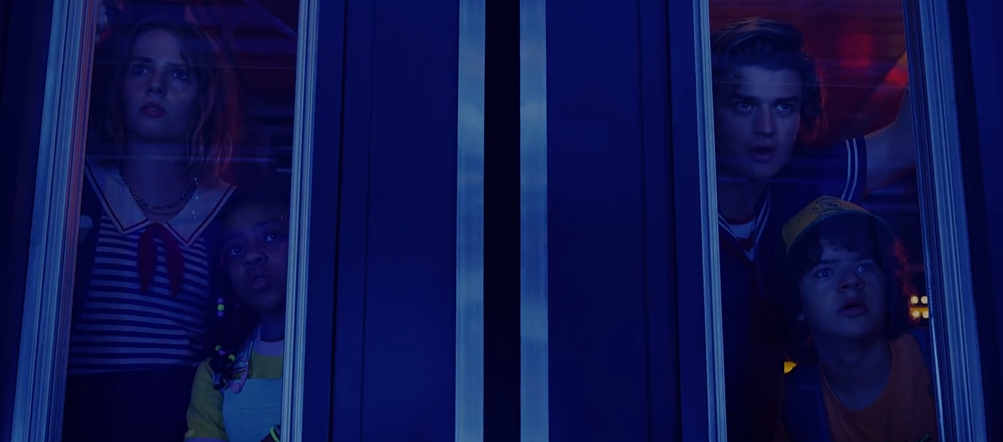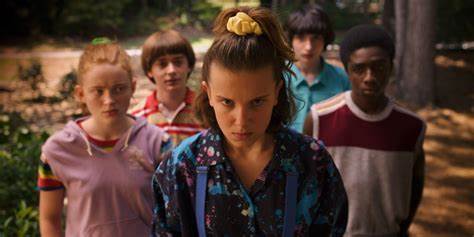On July 5, 2019th, I peeped episode 1 of Stranger Things 3 on Netflix. And here’s some of my impressions about “Chapter One: Suzie, Do You Copy?” This installment had me thinking.
To begin, as noted in the Stranger Things 3 trailer, you hear an apocalyptic message about season 3 of Stranger Things. The narrator of the trailer says, “You let us in. And now, you are going to have to let us stay. We’re going to end you. We’re going to end your friends. And we are going to end everyone.” It should be noted, this voice sounds electronic and there’s lots of shots of Americans with guns; plus, there is lots of shots of Russians. Perhaps, this season suggests a whole play on the American versus Russian thing.

Also, here’s another point about this segment of Stranger Things 3: I noticed the whole Russian military/science experiments. In an opening scene, you see some Russian employees being killed in a secret Russian laboratory experiment, which reminded me of the whole Chernobyl nuclear disaster; furthermore, in this scene, the TV caption says the incident took place on June 28, 1984. At this time, lots of secret stuff was going on in Russia, which was secret to Americans.
That being said, “Chapter One: Suzie, Do You Copy?” employs heavy use of gimmicks. For example, the use of CGI was used quiet a bit in lots of scenes. In one shot, you see a power generator, which I am pretty sure was created by Adobe After Effects plugins. Plus, they had this clip of a secret Russian base in Siberia, Russia. There was a rat scene too, which was CGI. Yeah, this episode of Stranger Things really went heavy on CGI.

As well, this episode touched on whole 80s mall rise, which started in mid 70s and progressed throughout the 80s. Of course, everyone hung out at the malls because there was nothing else to do. In fact, in one scene, Lucas Sinclair called his sister a “mall rat” as he tags along with his friends at the mall. During this time, urban space was being reshaped in the 80s via the mall.

Notably, at the same time, this episode made some good social commentary about malls. In one scene, Nancy Wheeler, a local writer and Hawkins Post gopher, discusses the consequences of the Starcourts mall on the community, “It’s changing the fabric of our town,” she tells an uninterested Hawkins newpaper staff. Additionally, one reporter jokes, laughing, “The death of small town America!” as he next orders Nancy to put some condiments on his burger. This episode stressed the fact that most Americans weren’t conscious of impact of malls on small town America at this time.
Interestingly, this episode tied malls with zombie movies. In the movies, the rise of malls were considered apocalyptic for small businesses at this time. And the zombies were considered materialistic individuals caught up in the false religion of consumerism versus a spiritualistic, meaningful way of life. During one scene, you see the kids of Stranger Things watching the movie Day Of The Day at the theater, which they sneaked in because they had no money. This episode did a good job of linking these two phenomena, which were on the minds of many Americans in the 80s.

In regards to other social statements on the American way of life in the 80s, this episode made another glaring statement: There were few women as news reporters. In one scene, you see the staff of the Hawkings Post, which is comprised of all white male reporters; and the only female in the news room is Nancy who is a gopher for the male reporters. Plus, Nancy faces constant sexual harassment on the job. However, It should be noted, women did not make up a majority of any news reporting staff on a local newspaper during this time.
Strangely, too, this episode reminds us how much advertising has changed over the years. In one scene, you see Joyce Byers putting up a big paper banner for a local drugstore sale, which reads 70 percent off. In other shots, you see other businesses’ have signs reading “Closed” or “Going Out Of Business”. In fact, in one shot, the local Radio Shack is going out of business. Plus, the local town hall meeting poster is hand drawn, which would be strange to see in our time. Nevertheless, today, electionic billboards and the internet have taken over the place of paper banners and signs in advertising.

As well, “Suzie, Do You Copy?” touched on the fact of the single headed family. We learn Chief Hopper, a local Hawkins police chief, is raising a daughter alone. Plus, Joyce Byers, single mother, is raising her two sons alone. Further, Karen Wheeler, an unsatisfied mother and wife, is running around with a local hunk. In the 1980s, we saw the decline of the nuclear family/traditional family in America; that being said, blended family was on the horizon.
Throughout this episode, too, we got an idea of Russian standards. First, we learn smoking is allowed in Russian government facilities. Also, the Russian governemt will fund a science project even if Russian workers die as a result of project. Also, the Russian military will use murder on it’s Russian employees. To an American citizen, these Russian standards may seem very different to say the least.

Towards the end of this show, Dustin picks up some Russian coded sentences on his ham radio. The codes make no sense, but Dustin seems to think they mean something. Perhaps, Dustin remembers the code breakers of World War 2. That being said, we have to remember that it was not even 30 years after the Cold War in the 1980s; therefore, people still had a Russian invasion on their mind at this time.
Also, throughout this broadcast, we learn Dustin is in some kind of transition. We get a hint when Will Byers says to Dustin, “Um, it’s late. Sorry, maybe tomorrow we can play D And D. Or something fun like we used to. Welcome home.” It seems the kids of Stranger Things have other things to do.
Coincidentally, this episode offered a moral message. For example, in a scene, we see Billy Hargrove, the local hunk and rebel, smash up his car crash on his way to cheating with Karen Wheeler; that being said, the underlying moral message seems to be: If you fool around with a married woman, you get hurt. I thought it was kind of a strange message to throw into the mix.
Overall, I kind of liked “Chapert One: Suzie, Do You Copy Me?” I liked the play on the whole connections between the USA and Russians in the 1980s. And I liked the part of few female reporters in the USA in the 1980s. Plus, the rise of the mall, transformation of urban space, and it’s impact on small town America was great. This episode seemed to have everything, and it had me thinking, which I enjoyed.
